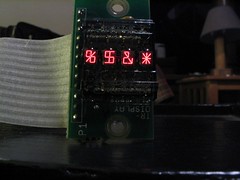First Upgrade
The first upgrade I did was to print out Thingiverse part number 215294 to increase the build volume from 100mm on the X-axis to 160mm. This was a huge step forward as it greatly increased the number of useful object I could print. It was a relatively simple print (everything was oriented to print on the stock bed) and only required a few parts to be purchased. These parts were:- 8mm smooth rod (McMaster-Carr part# 88625K67 or on Amazon)
- 608 skate bearings (McMaster-Carr part# 5972K222 or on Amazon)
- Printrbot GT2 Kit (From Printrbot)
- Miscellaneous M3 screws (Hardware store, McMaster-Carr, Amazon, etc.)
I followed the instructions from the Thingiverse listing and everything went quite well. I cut the 36" rod that I bought in half and only used a small portion of these with the original bed. I used this setup for a couple of weeks before starting to get the itch to grow the printer further.
A few notes of caution: this build isn't for the feint of heart - it involves dismantling most of the bottom of the printer since the motor plate has to be replaced with a printed piece. Also, don't make the mistake I did and let the nut fall out for the top screw on the left side. It took me quite some time to wiggle that guy back into the right place using a magnetized screwdriver, a steady hand and many attempts. Also, make sure you clean the extra plastic off of the protuberance that hits the X-axis limit switch. I didn't do this at first and was greeted with a very sickening (although not damaging) noise as some of the layers separated.
Second Upgrade
The second upgrade I did was Thingiverse part number 257841 which is a beefier version of the first, but without the adjustable piece that would allow usage of the original bed. If I were to start over from the beginning, i would print just that piece from the previous build and the rest of this build. That would allow the better end-pieces with the adjustable nature of the original. Live and learn! Since I didn't do the adjustable piece and I had planned from the beginning to make a super-big bed, I replaced the stock bed with a piece of Lexan that I cut with a jigsaw and drilled for the screws. I would definitely thing about having this laser cut if that's an option and am considering getting a second piece and having that done. The result would be a lot cleaner and more precise, but this is working for now on the cheap. I've been printing directly on the Lexan, which produces nice shiny first layers and the adhesion has been quite good.
I changed the way the timing belt is attached by using one tension block on each end instead of just on one. I also used Thingiverse part number 275874 to wedge into the opening on the tension blocks so that I could use the timing belt without cutting the belt. This has worked great for giving extra control over the tension and to prevent having to modify the belt in case I ever decide to go "just a little bit bigger"
The keen-eyed reader will notice that the bed is quite a bigger along the Y-axis than it would need to be for the standard Y carriage and the keen reader would be right! This is all the farther I've gotten so far, but there will be more to come (one piece of the next upgrade is on the printer as I type this).






